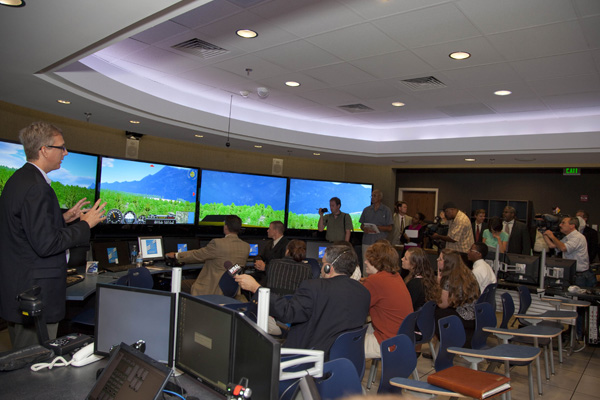October 12, 2009
JHU brings virtual learning to Baltimore County schools
Software engineers at Johns Hopkins have developed a prototype Virtual Learning Environment

Software engineers at Johns Hopkins’ Applied Physics Laboratory, in collaboration with JHU’s Center for Technology in Education, have developed a prototype Virtual Learning Environment to provide Baltimore County students with a gaminglike experience to augment existing math and science curricula.
The first of its kind in the nation, the VLE is located at Chesapeake High School in Essex, Md. It is deployed in a new facility modeled after a state-of-the-art 3-D visualization facility at APL, used for Department of Defense and NASA projects, called ARENA for Augmented Reality Environment at APL.
Like the ARENA lab, the Virtual Learning facility at Chesapeake High School includes 10 high-definition 72-inch TV monitors arranged in two five-screen semicircles. Students will interface with what they see on screen using a custom-designed digital switch and touch-panel controller. Additionally, an adjoining classroom housing 30 workstations, each outfitted with three monitors, will run the same scenarios as the larger virtual facility so that lessons can be applied on an individual or team basis.
The first 3-D virtual environment the students will experience is a geographically accurate terrain model of the area surrounding Mount St. Helens in Washington state. They’ll traverse the area in a “vehicle” that can morph from an aircraft to a car or boat, encountering learning challenges involving virtual characters, animals or other 3-D objects specific to the curriculum being addressed. The APL-developed software enables teachers to customize the learning modules by adding resources such as documents, Web sites, photos and videos.
“We’re providing a very compelling environment to excite students about math and science,” said Jim Miller, APL’s senior software engineer for the project. “It’s a different way for them to learn, and for teachers to present, math and science concepts.”
Tim Frey, assistant supervisor of the APL group developing the Virtual Learning Environment prototype, said, “This is a unique opportunity to work with other Johns Hopkins personnel and transition technology designed for the government to meet a critical educational need in our community, which reflects a larger educational crisis in our country. Studies have shown that U.S. students are lagging behind in math and science, and we hope this pilot program will capture and maintain students’ interest in these subjects and help expose them to careers in these fields as well,” he said.
Although the tool will initially augment math and science curricula, the school also plans to use the Virtual Learning Environment for additional content areas, such as English and social studies courses. During the next year, APL will develop other virtual environments, such as the lunar South Pole. Future software developments will enable teams of students to simultaneously use the system, and will enable teachers to embed quizzes within the learning modules.
The Virtual Learning Environment project grew out of a recently completed U.S. Department of Education “Star Schools” grant, initially awarded to Maryland Public Television, focused on the potential of gaming and simulation technologies to provide contextual, active and effective learning experiences. For this project, APL is responsible for software development to support deployment to Chesapeake High School’s VLE. JHU’s Center for Technology in Education is helping Chesapeake teachers develop curricula and scenarios for the prototype, and is training teachers to use the system.

